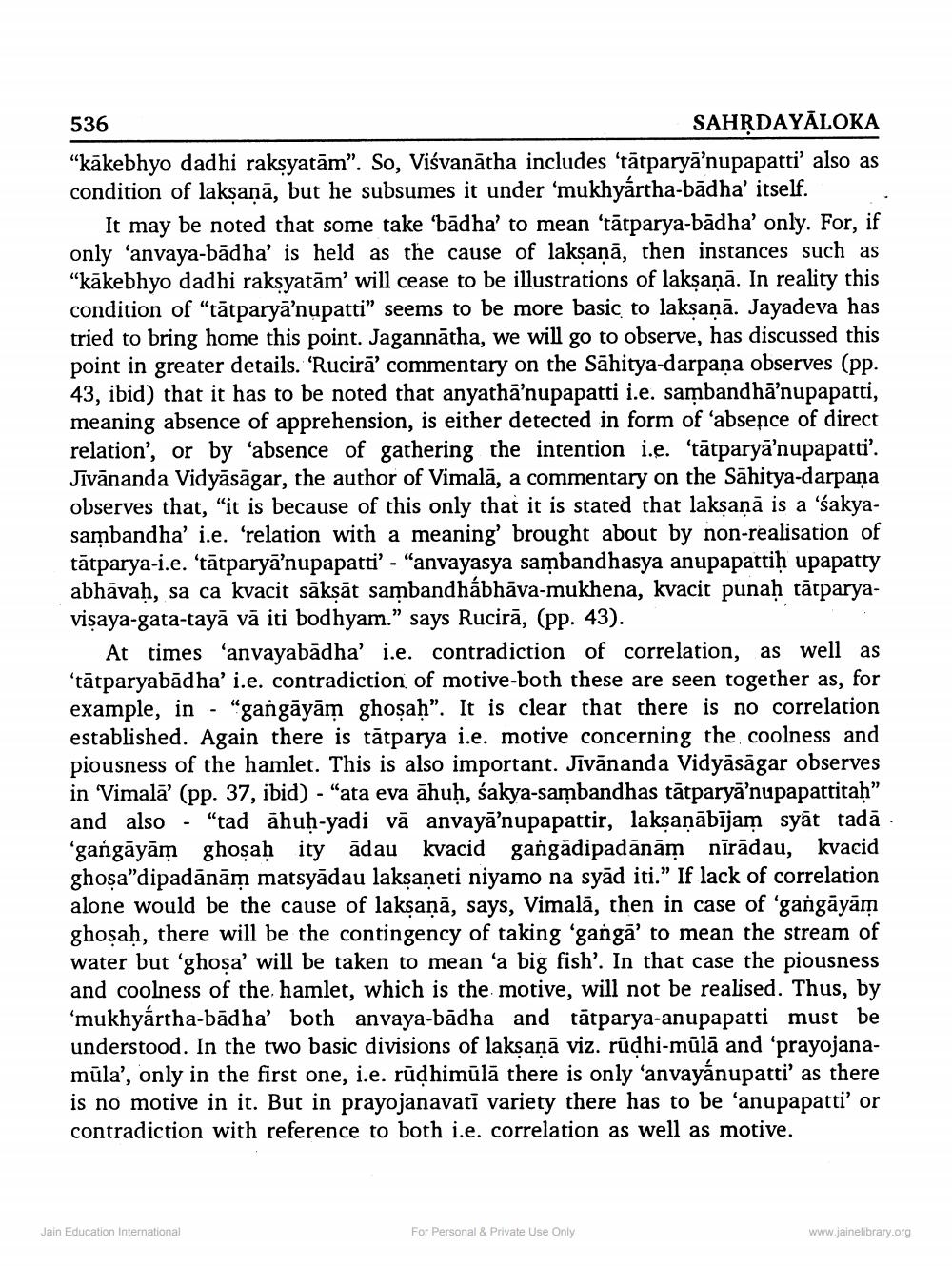________________
536
SAHĶDAYĀLOKA "kākebhyo dadhi raksyatām". So, Viśvanātha includes 'tă
yo aaani raksyatam". So, visvanatha includes tatparya'nupapatti' also as condition of lakṣaṇā, but he subsumes it under ‘mukhyartha-bādha' itself.
It may be noted that some take 'bādha' to mean 'tātparya-bādha' only. For, if only ‘anvaya-bādha' is held as the cause of laksaņā, then instances such as “kakebhyo dadhi raksyatām' will cease to be illustrations of laksanā. In reality this condition of "tātparyā’nupatti" seems to be more basic to laksaņā. Jayadeva has tried to bring home this point. Jagannātha, we will go to observe, has discussed this point in greater details. 'Rucirā' commentary on the Sāhitya-darpana observes (pp. 43, ibid) that it has to be noted that anyathā’nupapatti i.e. sambandhā’nupapatti, meaning absence of apprehension, is either detected in form of 'absence of direct relation', or by 'absence of gathering the intention i.e. 'tātparyā’nupapatti'.
ivananda Vidyasagar, the author of Vimalā, a commentary on the Sahitya-darpana observes that, “it is because of this only that it is stated that laksanā is a 'sakyasambandha' i.e. 'relation with a meaning' brought about by non-realisation of tātparya-i.e. 'tātparyā’nupapatti' - "anvayasya sambandhasya anupapattiḥ upapatty abhāvah, sa ca kvacit saksāt sambandhábhāva-mukhena, kvacit punah tātparyavisaya-gata-tayā vā iti bodhyam." says Rucirā, (pp. 43).
At times 'anvayabādha' i.e. contradiction of correlation, as well as ‘tātparyabādha' i.e. contradiction of motive-both these are seen together as, for example, in - "gangāyām ghosah". It is clear that there is no correlation established. Again there is tātparya i.e. motive concerning the coolness and piousness of the hamlet. This is also important. Jivānanda Vidyāsāgar observes in 'Vimalā (pp. 37, ibid) - “ata eva āhuḥ, śakya-sambandhas tātparyā’nupapattitaḥ” and also - “tad āhuh-yadi vā anvayā’nupapattir, laksaņābījam syāt tadā ‘gangāyām ghoṣaḥity ādau kvacid gangādipadānām nīrādau, kvacid ghosa"dipadānām matsyādau laksaneti niyamo na syad iti." If lack of correlation alone would be the cause of laksana, says, Vimala, then in case of 'gangayam ghosah, there will be the contingency of taking 'gangā' to mean the stream of water but 'ghosa' will be taken to mean 'a big fish'. In that case the piousness and coolness of the hamlet, which is the motive, will not be realised. Thus, by 'mukhyártha-bādha' both anvaya-bādha and tātparya-anupapatti must be understood. In the two basic divisions of laksaņā viz. rūdhi-mūlā and 'prayojanamūla', only in the first one, i.e. rūdhimālā there is only 'anvayánupatti' as there is no motive in it. But in prayojanavati variety there has to be 'anupapatti' or contradiction with reference to both i.e. correlation as well as motive.
Jain Education International
For Personal & Private Use Only
www.jainelibrary.org




